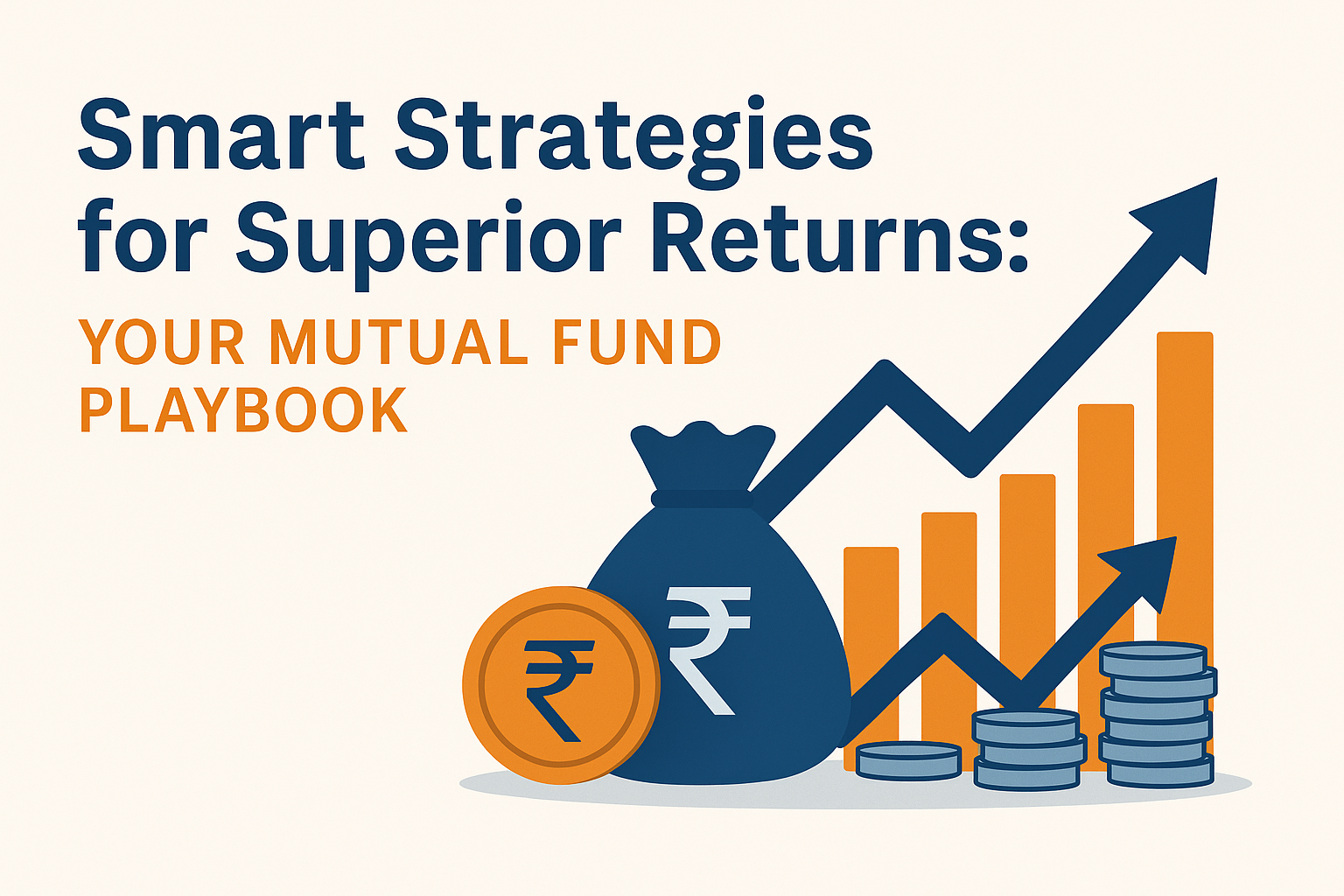Are mutual fund terms too confusing to act on? Read this blog for a clear path to mutual fund portfolio enhancement.
Started investing in mutual funds lately, but somehow your returns don’t match your expectations? It’s a common gap between putting your money and actually knowing how it’s working for you. While India’s mutual fund industry reached ₹72.2 trillion in AUM in May 2025 and SIP inflows hit ₹26,688 crore, many investors still struggle to understand the true measures for portfolio enhancement. This blog will help you change that. With simple actionable tips, we’ll help you fine tune your strategy and make the most of your mutual fund investment.
What are Mutual Funds & Its Returns
Mutual funds are investment vehicles that aggregate capital from multiple investors. This collective pool is then professionally managed by Asset Management Companies (AMCs), who invest it across a diversified range of securities like stocks and bonds, aligning with the fund’s objectives. This pooling inherently offers diversification benefits, spreading risk across various assets. A fund’s NAV or Net Asses Value, represents its current per-unit value, updated daily to reflect the latest market performance of its assets. The entire industry is rigorously regulated by the Securities and Exchange Board of India (SEBI), ensuring investor protection and transparency.
For a clear understanding returns from your investment, you’ll generally look at two main ways to measure performance:
- Absolute Returns: This simply shows the total percentage increase or decrease in your investment from when you first put money into its current value. It doesn’t factor in the duration you’ve owned the investment. For example, if you invested ₹100 and it became ₹120, your absolute return is 20%, whether that took 6 months or 11 months. It’s most helpful for short-term views, usually less than a year
. - Annualised Returns (or CAGR): When your investment has been held for more than a year, Annualised Returns, also known as Compound Annual Growth Rate (CAGR), give you a much better picture. This figure shows how much your investment grows on average each year, assuming all profits are reinvested annually. By averaging out market highs and lows, it offers a steady annual return, making fund comparisons over time much clearer.
Classification of Mutual Funds: Finding Your Fit
Mutual fund schemes are categorized as per SEBI guidelines issued in October 2017 to meet diverse investor needs. Learning how schemes are classified can make your investment choices more focused and goal-driven.
- Equity Schemes: These schemes focus mostly on stocks and equity-related assets, aiming for the future development. While these funds may rise and fall in the short term, they’re built for investors who can stay calm and committed over the years. Equity fund categories include Multi Cap, Large Cap, Mid Cap, Small Cap, and specific types like Sectoral/Thematic funds focusing on particular industries or themes, and ELSS (Equity Linked Savings Scheme) which offers tax benefits with a 3-year lock-in.
- Debt Schemes: Debt-oriented mutual funds, commonly referred to as income funds, channel your money into fixed-return assets such as government securities, company-issued bonds, etc.. They focus on income generation and capital preservation, making them generally less risky than equity funds. Debt funds are categorized based on the maturity of securities (e.g., Overnight, Liquid, Short Duration, Long Duration) or issuer (e.g., Corporate Bond, Gilt Fund).
- Hybrid Schemes: These funds mix both equity and debt, aiming to grow your wealth while keeping some cushion against market swings. SEBI has further classified Hybrid funds into categories like Conservative Hybrid Fund, Balanced Hybrid Fund, and Aggressive Hybrid Fund, varying the equity and debt allocation to suit different risk preferences. Dynamic Asset Allocation funds and Arbitrage funds also fall under this broad category.
- Solution Oriented Schemes: These are particularly built for life goals, such as planning your retirement or saving for your child’s future, giving your investments a clear direction. They typically have lock-in periods (e.g., 5 years or until retirement/majority age) to encourage long-term savings towards these objectives.
- Other Schemes: This category includes:
- Index Funds: Passively managed funds that mirror a specific market index, investing in the same securities and proportions as the index. They offer market returns without active fund manager decisions.
- Exchange Traded Funds (ETFs): Similar to Index Funds as they also track an index but are traded on stock exchanges throughout the day, like regular stocks. ETF units are compulsorily held in Demat mode.
- Fund of Funds (FoF): These schemes invest in units of other mutual fund schemes, providing diversification across multiple underlying funds through a single investment.
Smart Strategies for Superior Returns: Your Mutual Fund Playbook

To truly work towards your mutual fund portfolio enhancement and achieve better returns, consider these easy yet effective tips:
- Plan Your Course
Before you put your money into mutual funds, figure out what you’re saving for. Having clear goals is super important because they’ll guide every investment choice you make, from the kind of mutual fund to pick, to how much you invest, and for how long. Knowing your target helps you choose funds that truly fit your personal needs and timeline.
- Get Real about Risk
Mutual funds aren’t guaranteed; you could lose your principal. Their value changes because of market shifts, interest rates, government policies, and trading volumes.
Stock investments face price risk from daily swings and liquidity risk if it’s hard to sell. Debt investments carry credit risk (if the issuer can’t pay back) and interest rate risk (bond prices falling when rates go up).
For example, in 2024, some equity funds, like the Quant PSU Fund, saw negative returns on SIP investments. This happened due to price risk or market risk, where specific stocks or sectors within the fund underperformed.
Hence, knowing about your personal risk threshold isn’t optional, it keeps you from making decisions you’ll regret.
- Invest via SIPs
Systematic Investment Plan (SIP) is an investment method offered by mutual funds. Even with just a small amount or merely ₹500, you can begin investing. With this approach, your money goes in regularly. When markets fall, you buy more units; when they rise, you buy fewer, this technique evens out your costs over time.
For example, a ₹500 SIP might get 20 units at NAV ₹25, then 50 units at NAV ₹10, averaging your cost. SIPs are ideal for long-term investing, helping you harness the power of compounding and avoid market timing worries.
- Diversify
Think of diversification as packing for a trip, diversify your resources so no single setback derails your progress. Spread investments across various mutual fund types, assets like stocks, bonds, or gold, and diverse industries. This lowers risk: if one investment struggles, others can perform well, protecting your total portfolio. It’s a key strategy for stable investing.
- Know About Taxes
Learning about taxes on mutual funds helps you get better returns. For equity funds, if you hold them for over a year, any profits (long-term gains) are taxed at 12.5%. Sell them within a year, and your short-term gains will face a 20% tax. For debt funds, holding them for over two years results in a 12.5% tax on long-term gains. If profit made on investments held for under two years are taxed as regular income, meaning they’re added to your annual earnings and taxed according to your slab.
Also, be aware of withholding tax: 10% for residents, and 20% for Non-Resident Indians (NRIs).
- Watch Out for Fees
Mutual funds charge an annual Total Expense Ratio (TER), covering all operating expenses like management and marketing. This fee, a percentage of the fund’s daily net assets, directly reduces your returns; a lower TER yields a higher Net Asset Value (NAV). SEBI’s Regulation 52 sets varying TER limits, revised April 1, 2020. For instance, on the first Rs. 500 crores AUM, equity funds can charge up to 2.25% and debt funds 2.00%.
Above Rs. 50,000 crores, these drop to 1.05% and 0.80% respectively. Funds can also charge up to 30 bps more for new retail inflows from “Beyond Top 30” cities under specific conditions. Always check this daily disclosed fee, as it’s crucial for your net gains.
- Think Long-Term
Mutual funds, especially equity-oriented ones, are generally designed for long-term wealth creation. Chasing the perfect entry or exit point in the market is a gamble most lose, consistency beats guesswork when it suboptimal returns. Long-term investing gives your money the chance to grow steadily, smoothing out market bumps and letting compounding do its magic over time.
Patience and a long-term perspective are important to holding the full potential of your mutual fund investments.
- Reviewing Regularly is Important
While thinking long-term is essential, it doesn’t mean you should ignore your investments. To keep your investments on track, it’s essential to revisit your mutual fund portfolio periodically and adjust based on your evolving goals and risk tolerance. Market conditions, your personal circumstances, and fund performance can change over time.
Periodically assessing your portfolio allows you to make necessary adjustments, rebalance your asset allocation, or switch funds if they consistently underperform their benchmarks or no longer fit your objectives. This proactive approach helps keep your investment strategy on track.
Conclusion
Investing in mutual funds requires more than just commitment, it calls for understanding returns and focusing on consistent portfolio enhancement. From tracking expenses to reviewing regularly, each step adds clarity. To make the process simpler and more aligned with your needs, consider consulting a trusted trading platform. The right support can help you evaluate options clearly and make choices that reflect your overall strategy.
- Make in India 2.0: How Manufacturing Is Reshaping Market Sentiment - December 13, 2025
- Real Estate Boom : Why Tier-2 Cities Are Attracting Big Investors - December 12, 2025
- India’s GDP Surge 2025: What the New Growth Numbers Mean for Markets - December 9, 2025





